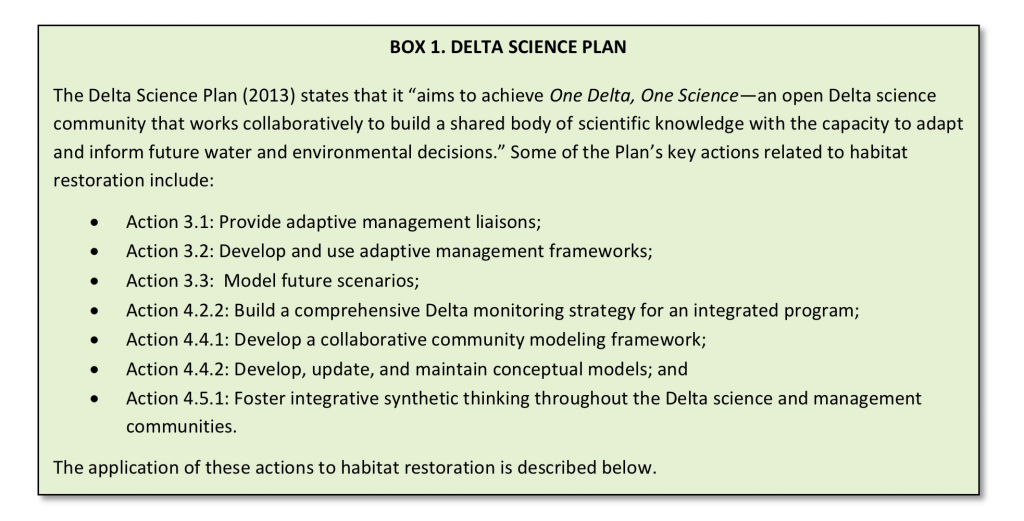The Delta Stewardship Council’s Jessica Davenport, Program Manager, Ecosystem Restoration and Land Use, released an issue paper in August of last year entitled “Restoring Habitat with Science and Society in Mind”. 1
“The Delta Plan shall include measures that promote all of the following characteristics of a healthy Delta ecosystem:
- Viable populations of native resident and migratory species.
- Functional corridors for migratory species.
- Diverse and biologically appropriate habitats and ecosystem processes.
- Reduced threats and stresses on the Delta ecosystem.
- Conditions conducive to meeting or exceeding the goals in existing species recovery plans and state and federal goals with respect to doubling salmon populations.”
The Delta Plan,2 much like the Governor’s Bay Delta Conservation Plan (BDCP),3 has no measures that would promote a healthy Bay-Delta ecosystem. The plans virtually ignore water habitat: the characteristics of the water in the hundreds of miles and tens of thousands of acres of open water in the Bay-Delta. The plans fail to even define the components of a healthy ecosystem or how they relate to water habitat:
- “viable populations” – what constitutes viable?
- “functional corridors” – what is functional?
- “appropriate habitats and ecosystem processes” – what is appropriate?
- “threats and stresses” – what threats and stresses?
- “conditions conducive to doubling salmon populations” – what conditions?
The plans simply focus on “restoration” of thousands of acres of edge habitat on marginal lands in Suisun Marsh and the Delta, virtually ignoring the “real problem” and its fixes. The “restoration” that is promoted will take decades to implement and will do little to promote a healthy ecosystem, at least in the short term.
The “real problem” is water management in the Central Valley and Bay-Delta. The “real problem” is our insatiable demand for water while virtually ignoring the beneficial uses and public trust requirements of the Central Valley and Bay-Delta ecosystems. There are water quality standards and endangered species biological opinions that provide minimal protections for resident and migratory native fish species. Yet the first thing that regulators do in droughts is relax these protections to provide more water for agriculture. As a consequence, the fish populations and their habitats suffer irreversibly in drier years, and especially in extended periods of drought. The result is fish populations on the verge of extinction, poor Bay-Delta water quality, salt in Delta water diversions, salmon smolts having to be trucked hundreds of miles from hatcheries to the Bay, and no freshwater inflow to the San Francisco Bay estuary.
Water is the ecosystem process ignored in the BDCP and Delta Plan. The characteristics of the water habitat in time and space are the missing element in the plans. The fish habitat that is most important is the water in Delta channels and bays, not the acreage of tidal marsh. Adding tidal marsh habitat will not fix the water habitat or provide a healthy ecosystem
The BDCP justified taking more water via the “tunnels” by offering thousands of habitat acres in return. The Delta Plan promotes these same land acreage solutions.
How can we really restore the Delta as habitat for smelt, salmon, steelhead, sturgeon, and other native fishes? We have to focus on Delta inflows, outflows, tides, and exports: hydrology, salinity, water temperature, and primary productivity patterns in the water habitat. The real habitat of the Delta is the three-dimensional characteristics of water in time and space. What should the water habitat be for Delta smelt when they hatch in the spring to insure good survival? How do we sustain the smelt in summer? Can they actually survive if all the Delta inflow is exported in August under relaxed standards? What happens to all the wild salmon smolts coming out of Central Valley rivers? What kind of water habitat do they need to pass through the Delta? They do not get a truck ride to and around the Delta. What is a “functional migration corridor” for them?
So instead of focusing on acreage, we should focus on the real habitat, water and all of its characteristics in time and space in the Delta, rivers, and the Bay. That way, we can promote the real ecosystem process that provides for a healthy Bay-Delta ecosystem.
The Delta Science Plan4 is just more talk and smoke and mirrors. What the Delta needs is more water and better water habitat. We do not need a new vision.

